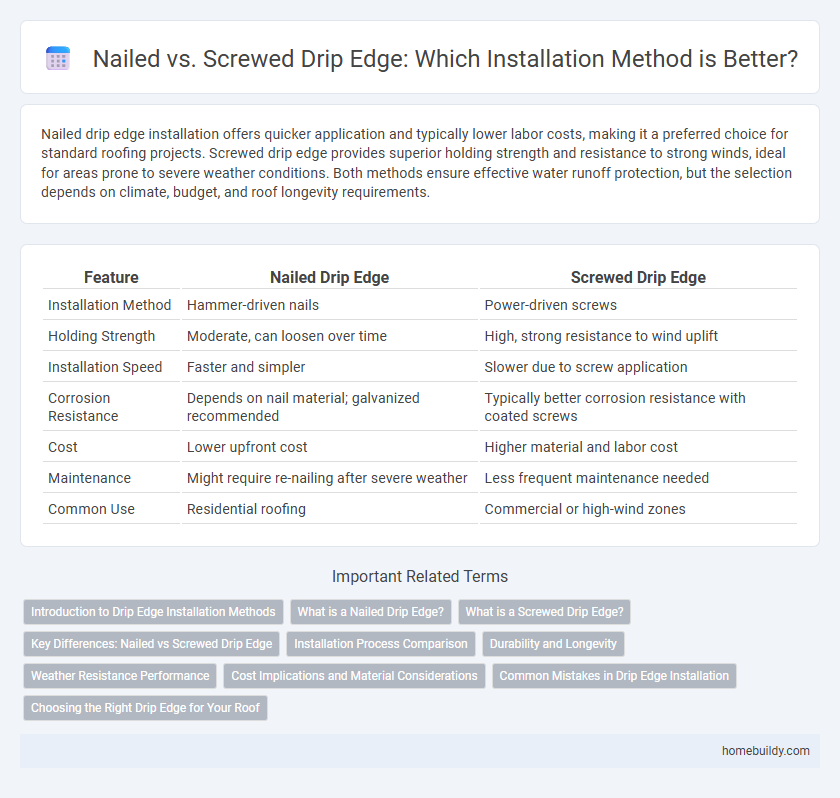Nailed drip edge installation offers quicker application and typically lower labor costs, making it a preferred choice for standard roofing projects. Screwed drip edge provides superior holding strength and resistance to strong winds, ideal for areas prone to severe weather conditions. Both methods ensure effective water runoff protection, but the selection depends on climate, budget, and roof longevity requirements.
Table of Comparison
| Feature | Nailed Drip Edge | Screwed Drip Edge |
|---|---|---|
| Installation Method | Hammer-driven nails | Power-driven screws |
| Holding Strength | Moderate, can loosen over time | High, strong resistance to wind uplift |
| Installation Speed | Faster and simpler | Slower due to screw application |
| Corrosion Resistance | Depends on nail material; galvanized recommended | Typically better corrosion resistance with coated screws |
| Cost | Lower upfront cost | Higher material and labor cost |
| Maintenance | Might require re-nailing after severe weather | Less frequent maintenance needed |
| Common Use | Residential roofing | Commercial or high-wind zones |
Introduction to Drip Edge Installation Methods
Nailed drip edge installation involves securing metal flashing with roofing nails, providing a traditional and cost-effective method that ensures the drip edge remains firmly attached to the roof deck. Screwed drip edge uses corrosion-resistant screws, offering enhanced durability and resistance to wind uplift, making it ideal for areas prone to severe weather. Both methods aim to protect roof edges from water intrusion and direct rainwater away from the fascia and underlying roofing components.
What is a Nailed Drip Edge?
A nailed drip edge is a metal flashing installed along roof edges using roofing nails to secure it firmly to the decking, ensuring effective water runoff and preventing roof damage. This type of drip edge provides a tight seal against wind-driven rain and is typically preferred for its speed and ease of installation compared to screwed alternatives. Proper nailing placement is crucial to maintain the drip edge's functionality and durability, helping extend the roof's lifespan by protecting the underlying structure.
What is a Screwed Drip Edge?
A screwed drip edge is a roofing component secured to the roof deck using corrosion-resistant screws, providing enhanced stability and resistance to wind uplift compared to nailed drip edges. This method ensures a tighter seal along roof edges, effectively directing water away from the fascia and preventing water damage to the underlying structure. Using screws also facilitates easier maintenance and removal, making it a preferred choice in regions prone to severe weather conditions.
Key Differences: Nailed vs Screwed Drip Edge
Nailed drip edges offer quicker installation with fewer tools and rely on roofing nails driven through the drip edge into the fascia board for secure attachment. Screwed drip edges provide stronger, more durable fastening by using corrosion-resistant screws, improving resistance to wind uplift and ensuring long-term stability, especially in high-wind areas. While nailed drip edges are more cost-effective and common, screwed drip edges enhance structural integrity and reduce potential gaps, increasing the roof's overall protection against water infiltration.
Installation Process Comparison
Nailed drip edge installation involves securing metal flashing to the roof edge using galvanized roofing nails spaced approximately 8 to 12 inches apart, ensuring a quick and straightforward process suitable for various roof types. Screwed drip edge installation requires corrosion-resistant screws, which provide a stronger hold and enhanced wind resistance, ideal for high-wind regions but may take longer to install due to precise screw placement. Both methods require proper alignment along roof edges and underlayments to prevent water infiltration and protect roof decking from moisture damage.
Durability and Longevity
Nailed drip edges provide secure attachment but may loosen over time due to wood shrinkage and environmental stresses, potentially compromising durability. Screwed drip edges offer enhanced stability and resistance to wind uplift, contributing to increased longevity and consistent performance. Choosing screws ensures a more durable drip edge installation that better withstands weathering and structural movement.
Weather Resistance Performance
Nailed drip edges offer secure attachment but may be prone to loosening over time due to rust or nails backing out, potentially compromising weather resistance. Screwed drip edges provide enhanced stability and resistance to strong winds and heavy rain by maintaining a tighter seal against water infiltration. The use of corrosion-resistant screws further improves long-term durability and protection against moisture damage.
Cost Implications and Material Considerations
Nailed drip edge installation typically incurs lower labor costs due to faster application, but may require thicker gauge materials to ensure longevity and resistance to wind uplift. Screwed drip edge, while involving higher labor expenses because of increased installation time, allows for more precise fastening and is often preferred for metal roofing systems where material durability and secure attachment are critical. Material considerations also influence cost-effectiveness, with aluminum options favored for nailed drip edges due to flexibility and corrosion resistance, whereas galvanized steel is common for screwed installations due to enhanced strength.
Common Mistakes in Drip Edge Installation
Common mistakes in drip edge installation include improper fastening methods, such as using nails instead of screws or vice versa without considering the roof type and conditions. Nails may loosen over time due to wind uplift, causing gaps that allow water infiltration, while screws require correct placement and corrosion resistance to ensure durability. Ensuring the use of appropriate fasteners, spaced correctly and properly sealed, is critical to prevent water damage and maintain roof integrity.
Choosing the Right Drip Edge for Your Roof
Choosing the right drip edge for your roof depends on factors such as material compatibility, longevity, and installation environment. Nailed drip edges offer quicker installation and are suitable for standard roofing materials like asphalt shingles, while screwed drip edges provide a stronger hold ideal for metal or high-wind areas. Evaluating local weather conditions and roof structure ensures optimal protection against water damage and extends roof lifespan.
Nailed drip edge vs Screwed drip edge Infographic

 homebuildy.com
homebuildy.com